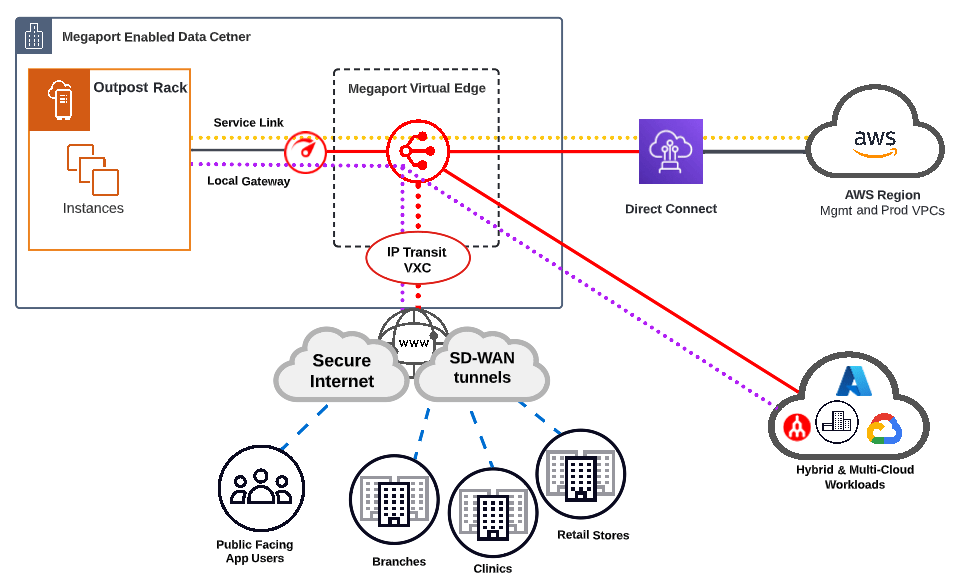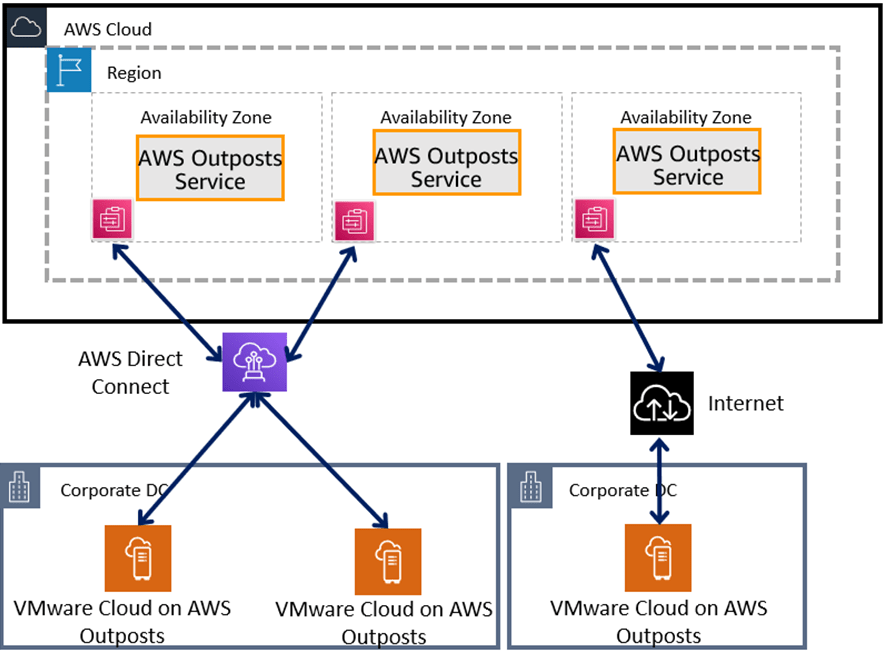
- Introduction to AWS Outposts
- How AWS Outposts Extend AWS Infrastructure
- Setting Up an AWS Outposts Environment
- AWS Outposts Use Cases
- Networking and Security Considerations
- Managing and Monitoring AWS Outposts
- Conclusion
AWS Outposts is a fully managed service that extends AWS infrastructure and services to on-premises locations, enabling a seamless hybrid cloud experience. It allows businesses to run AWS services locally while maintaining a consistent operating model with the AWS cloud. AWS Outposts is ideal for industries requiring low-latency processing, data residency, and regulatory compliance. AWS Training blog will explore AWS Outposts, its significance, and how organizations can implement it effectively. We will also discuss its benefits, use cases, and integration with AWS services to optimize workloads and enhance operational efficiency in hybrid cloud environments.
Start your journey in Docker by enrolling in this AWS Certification Training .
Introduction to AWS Outposts
AWS Outposts is a fully managed service that extends AWS’s infrastructure, services, and tools to on-premises locations. It allows you to run AWS services, infrastructure, and applications seamlessly within your data center or edge locations. By providing a consistent hybrid cloud experience, AWS Outposts enables organizations to run applications with low-latency requirements, comply with local data residency regulations, or maintain existing investments in on-premises hardware while still benefiting from the scalability, Security Challenges in Cloud Computing, and flexibility of the cloud.AWS Outposts are fully integrated with AWS services and are designed to provide a hybrid solution that complements on-premises environments by extending AWS’s infrastructure directly to on-premises locations. This integration ensures that applications running in both on-premises and cloud environments can share the same architecture, tools, and operational model.
How AWS Outposts Extend AWS Infrastructure
- Seamless Hybrid Cloud Integration: AWS Outposts allow organizations to run AWS services, such as EC2, S3, EBS, and RDS, on-premises, providing a hybrid architecture where on-premises resources are fully integrated with AWS’s public cloud. This results in a seamless extension of cloud resources into the on-premises data center.
- Consistent Management Experience: Outposts provide a consistent management experience by leveraging the same AWS Management Console, CLI, and SDKs used for Cloud Computing Project Ideas resources. Organizations can use the same tools to monitor, provision, and manage their workloads both in the cloud and on-premises, eliminating the need to manage separate systems for hybrid infrastructures.
- Run Cloud Services Locally: With AWS Outposts, users can run compute, storage, and database workloads locally on Outposts hardware, while being able to easily access additional cloud resources as needed. This flexibility makes it suitable for workloads that require consistent performance or compliance with regional data regulations, while still benefiting from the elasticity of the AWS cloud.
- Simplifying Hybrid Cloud Management: Outposts are designed to simplify the management of hybrid environments. By extending AWS’s infrastructure and offering support for cloud-native services, organizations can focus on building applications rather than managing complex hybrid architectures.
- Integrated Networking: Outposts are designed to provide low-latency connectivity with AWS’s global infrastructure. You can easily connect your on-premises Outposts with AWS services over AWS Direct Connect or AWS VPN, ensuring secure and fast communication between your on-premises and cloud environments.
- Low Latency Applications: AWS Outposts is ideal for applications that require low-latency processing, such as real-time data analytics, gaming, or machine learning. Running workloads locally on Outposts ensures that the data does not have to travel over the internet to the cloud, reducing latency and improving performance.
- Data Residency and Compliance: Outposts is well-suited for industries or regions with strict data residency or compliance regulations. With Outposts, organizations can store and process sensitive data on-premises, while still leveraging the AWS cloud for other services and scalability. This helps meet local compliance requirements while retaining cloud-native capabilities.
- Edge Computing: Edge computing applications, such as those in IoT or video streaming, can benefit from AWS Outposts by processing data locally at the edge and integrating seamlessly with AWS cloud services for further analysis or storage. Outposts provide a unified infrastructure for managing these hybrid workloads.
- Disaster Recovery: Outposts provide a powerful option for disaster recovery strategies by enabling on-premises applications to leverage cloud-based AWS resources for backup, failover, and data replication. In the event of a data center failure, you can quickly failover to AWS cloud services, ensuring business continuity.
- Hybrid Cloud Applications: Organizations looking to gradually migrate their on-premises Applications of Cloud Computing can use AWS Outposts to create a hybrid environment, where some workloads remain on-premises and others are migrated to the cloud. This enables a phased migration strategy without disrupting operations.
- AWS Management Console: The AWS Management Console provides a central interface to manage your Outposts environment. From here, you can provision resources, manage security configurations, monitor resource usage, and view operational insights.
- CloudWatch Integration: AWS Outposts integrates with Amazon CloudWatch, allowing you to monitor the performance and health of your Outposts hardware and services. You can track metrics such as CPU utilization, disk I/O, and network performance, and set up alarms for potential issues.
- AWS Systems Manager: You can use AWS Systems Manager to automate patching, configuration management, and deployment tasks on your Outposts resources. This service helps maintain the health and operational efficiency of your Outposts environment.
- AWS CloudTrail: For auditing purposes, AWS CloudTrail logs all API calls made to the AWS Outposts environment. This provides visibility into user actions, helping with troubleshooting, security audits, and compliance tracking.
- Service Health and Monitoring: AWS offers a Service Health Dashboard for AWS Outposts, providing insights into the status of your Outposts environment. This allows you to proactively monitor and address potential issues before they impact workloads.
- AWS Identity and Access Management (IAM): AWS IAM provides granular access control, allowing administrators to define user roles and permissions for AWS Outposts resources. By enforcing least privilege access, organizations can enhance security and prevent unauthorized access to critical workloads.
- AWS Direct Connect: AWS Direct Connect establishes a dedicated A Basic Guide to Computer Networks connection between on-premises infrastructure and AWS Outposts, ensuring low-latency and high-speed data transfers. This secure connection helps organizations maintain consistent application performance and optimize hybrid cloud workloads.
- Data Residency and Compliance: AWS Outposts enables businesses to store and process sensitive data on-premises while maintaining seamless integration with AWS cloud services. This ensures compliance with regional regulations and industry standards for data sovereignty and privacy.
- Automated Backups with AWS Backup: AWS Backup automates data protection for workloads running on AWS Outposts, simplifying backup scheduling and recovery processes. This service ensures data resilience, minimizing downtime and protecting against accidental data loss or corruption.

Gain in-depth knowledge of AWS by joining this AWS Certification Training now.
Setting Up an AWS Outposts Environment
Setting up AWS Outposts begins by choosing the appropriate configuration for your on-premises environment. Outposts come in various sizes and configurations based on your workload requirements, with options for compute capacity (EC2 instances), storage (EBS volumes), and networking. You can place an order for an Outpost through the AWS Management Console. During the ordering process, you specify the region and availability zones where you want the Outpost to be located. You also determine the configuration for compute, storage, and networking resources. Once your Outpost order is placed, AWS will ship the hardware to your data center or edge location. AWS will also provide installation assistance to ensure the hardware is installed properly and connected to AWS’s infrastructure. AWS engineers handle the physical setup of the servers and networking components. After the hardware is installed, you need to configure your network. AWS Training includes setting up Virtual Private Cloud (VPC) subnets and routing tables to ensure proper communication between the Outposts environment and the AWS cloud. You can configure network connectivity using AWS Direct Connect or VPN for a secure and low-latency link between your on-premises infrastructure and the cloud. Once the physical and network configurations are complete, you can start provisioning resources (compute, storage, databases) on the Outpost using the same tools and interfaces as AWS cloud resources. This ensures the same flexibility, scalability, and management tools as AWS in the cloud.
Aspiring to lead in AWS? Enroll in ACTE’sAWS Master Training Course and start your path to success!
AWS Outposts Use Cases
Networking and Security Considerations
To ensure that AWS Outposts can integrate seamlessly with your existing on-premises infrastructure and the AWS cloud, proper network configuration is essential. You can use AWS Direct Connect or VPN to establish a dedicated, secure connection to AWS, ensuring low-latency and high-throughput communication between Outposts and the cloud.Since AWS Outposts operates in your on-premises data center, careful planning for IP address management is crucial. Outposts supports private IP addresses within your VPC, and you can choose IP address ranges to avoid conflicts with your existing infrastructure. Like in the cloud, you can use Security Groups and Network Access Control Lists (NACLs) to define fine-grained access controls for workloads running on Outposts. These security mechanisms allow you to control traffic between VPCs, subnets, and on-premises networks, ensuring that your data remains secure. To protect sensitive data, AWS Outposts supports encryption at rest and in transit. AWS services such as EBS and S3 integrate with AWS Key Management Service (KMS) for managing encryption keys, ensuring that your data is protected both in the cloud and on-premises. Optimizing AWS Performance Costs supports various compliance frameworks such as HIPAA, GDPR, and PCI DSS. Organizations using Outposts for data residency and compliance can leverage these built-in controls to maintain their regulatory obligations.
Preparing for AWS interviews? Visit our blog for the best AWS Interview Questions and Answers!
Managing and Monitoring AWS Outposts

Conclusion
By leveraging AWS Outposts, organizations can seamlessly extend their AWS infrastructure to their on-premises locations, creating a hybrid cloud environment that combines the best of both worlds. With its flexible configurations, tight integration with AWS cloud services, and powerful security features, AWS Outposts provides a robust solution for managing large-scale, hybrid workloads.AWS Outposts enables businesses to run AWS services on-premises, ensuring low-latency performance and seamless cloud integration. AWS Training supports industries like finance, healthcare, and manufacturing by providing consistent infrastructure, security, and compliance. With AWS Outposts, organizations can modernize applications while maintaining data sovereignty and meeting regulatory requirements effortlessly.





